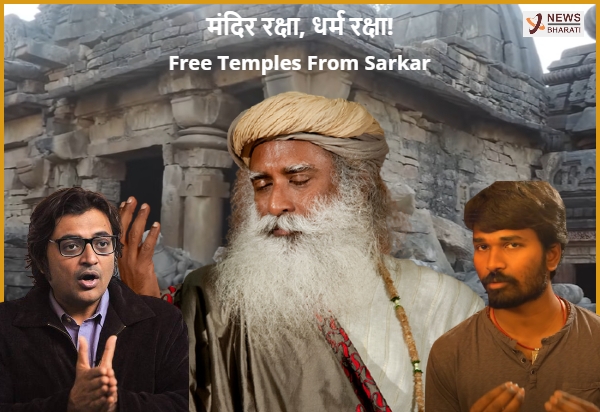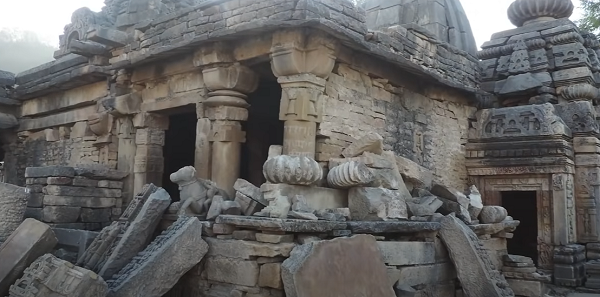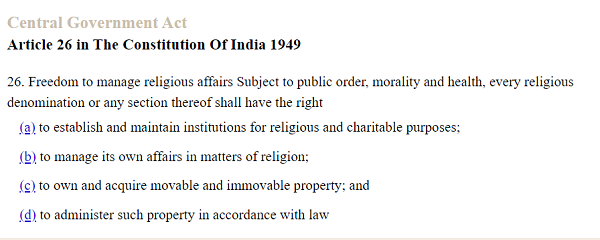मंदिर रक्षा, धर्म रक्षा! Freeing temples from Sarkar- The Science, the Law & the Purpose!
07 Apr 2021 10:30:54
Close your eyes. I pray you never be, but for now imagine that you are in some deep trouble. No option you are left with for justice.. not the family.. niether the honors.. nor the judiciary! The only one you see can help you is God. Where would you go find Him in first place? Temples? What if there are no temples? This sounds a bit scary but can be a reality for Gen Z, Z+ if we today fail to save the temples.

It seems that the Ayodhya chapter was not enough for the governments or the controllers to know what exactly a temples mean to Hindus? Concerning the cause in a strong message, Sadhguru, Founder-Isha Foundation has called on the Government of Tamil Nadu to free temples from state control to enable their upkeep, preserve their sanctity and reverse their alarming state of decline in Tamil Nadu. "To protect the thousands of temples in Tamil Nadu that are gradually being ruined, the Tamil Nadu government should free temples from the clutches of the government and hand them to the devotees," Sadhguru had tweeted tagging Chief Minister Edappadi Palanisamy, Opposition Leader MK Stalin and actor Rajinikanth. The tweet was part of a series of tweets that he had recently (March 27-29) released to highlight the pathetic state of temples under state control in Tamil Nadu.
Now what do you think made Sadhguru, the spiritual head pick up this issue? Is really the government of Tamil Nadu not maintaing the sanctity of the temples? Temples, the home to Gods as widely believed are the source of Tamil culture. Devotees in there value temples more than their lives. I remember my day in Padmanabhaswamy temple in Thiruvananthpuram when small. People were continuously staring at me and my sister, right from the moment we enetered in! As if we had done some crime and that our photographs were in newspapers reading 'WANTED'! Clueless of what was happening, one of the devotees may be seeing us come from different culture, told my father to buy us two some complete round bottoms. Yup! the pair of jeans were the problem! Devotees are also a matter of esteem in this part of India we realised then!
Shouldn't temples be cared for and managed by such devotees who value the very structure and the rooted culture there more than their lives? The desecration of temples is slow poison and it really is painful to see Government's allegedly purposeful neglect and apathy towards these vibrant spaces of worship. According to the Hindu Religious and Charitable Endowments Department looked after by the state submitted to the Chennai High Court last year that 11,999 temples are dying without a single pooja taking place. 34,000 temples are struggling with revenue of less than Rs 10,000 a year and 37,000 temples have appointed just one person for pooja, maintenance, security and more and his salary is less than minimum wages given under MGNREGA.
Further its also shameful to see that temples captured for greed by the East India Company 300 years ago, continue to languish in dilapidated states of utter neglect even 74 years after freedom from colonial rule. In an exclusive conversation with Republic Media Network's Editor-in-Chief Arnab Goswami, Sadhguru ominously said, "If the same situation persists, all but 10 important temples will not exist in the next 100 years. Right now, you are converting all temples into badly maintained museums. They are just crumbling all over the place. You need to understand such work of art, these are all over 1000-year-old temples, built at a time when there were no machines, no trucks, no cranes. But, the way they moved these rocks, the way they engineered them, carved them. Granite is the hardest rock to carve, they did it. What kind of people are these? These were the people so fired with passion. They did not build great homes for themselves, they lived in thatched-roof huts but they built these kinds of temples. That's the kind of passion that created these temples. If you want these temples to be alive you need people who have that kind of passion for the deity and the temple otherwise it will be just a building".
Callous and corrupt state government as custodians-
This sorry state of affairs is the direct result of temples being managed by the corrupt states, believes the Hindu Janajagruti Samiti. Several Hindu Religious and Charitable Endowments (HRCE) acts have allowed states to assume financial and managerial control of more than a hundred thousand Hindu temples. These HRCE departments are headed either by a cabinet minister or by ostensibly autonomous boards. According to a Supreme Court judgement, governments are free to appoint Marxists and non-believers to manage these departments.
During deliberations that preceded the passage of the landmark “Madras HRCE Act of 1951”, the premier of Madras, O P Ramaswamy Reddiar, assured the House of his government’s intention: “In bringing forward this Bill sir, let me make it clear that I have the highest interest of our faith at heart… The regulation of Hindu temples and maths is regulation of the community’s life and conduct; the revival of our temples is the revival of our people… If we do not make our temples a positive force, radiating a healthy progressive, social and cultural outlook, we shall be playing into the hands of the surging Godless crowd…”
How ironic then that temples are managed by Marxists in Kerala, atheist Dravidian parties in Tamil Nadu, or Christians as in Andhra Pradesh, who tried to build a church right on top of Tirumala. They have wreaked havoc on the financial sustainability of temples, although ostensibly practising Hindu politicians are also culpable. Virtually all of Reddiar’s stated intentions stand belied or worse. T S S Rajan, who introduced the bill in 1949, said, “Ours maybe called a secular government, and so it is. But it does not absolve us from protecting the funds of the institutions which are meant for the service of the people.”

This has been the pre-eminent rationale to justify government management of Hindu temples. In reality, state after state has used the precedent of Tamil Nadu to pass HRCE acts, seeing temple funds as cookie jars they can raid for all and sundry purposes. Mismanagement extends to all aspects of temple administration, and borders on the criminal. Rich temples such as Tirupati, Guruvayoor, or Mumbai’s Siddhivinayak temple have routinely been raided to fund state budget programmes or line politicians’ pockets, while what happens in Tamil Nadu can only be described as wholesale loot.
Financial mismanagement is compounded by gross incompetence when it comes to temple maintenance. There are numerous instances where ancient murals and paintings were white-washed, mandapams were demolished and walls sand-blasted causing precious inscriptions to disappear. While the government eventually issues notifications acknowledging the errors of such senseless acts, the damage is already been done, and new forms of egregious violations occur at other temples. There are long running rackets in the smuggling of exquisite ancient sculptures abroad and while there have been some notable successes in recapturing artifacts recently, they remain the tip of the iceberg. Moreover, the initiative and intelligence for these successes come from private efforts, like the one initiated by the India Pride Project.
Such a loot has been the inevitable outcome since modern bureaucratic control of temples commenced during the British rule. The first Collector of Chengalpattu, Lionel Place, noted in his report on the jagir of 1799 that, soon after he became the Collector, he took over the “management of the funds of all the celebrated pagodas” into his own hands and allocated expenses for their festivals and maintenance. By 1801, these were converted to “fixed money allowances” under a “permanent settlement”.
An article on the Tirupati temple by the collector of North Arcot in the Asiatic Journal in 1831, is even more explicit: “It was a strange but determined piece of policy when throughout the country the pagoda lands were resumed by the company and tusdeck allowances were granted in their place… Now let us contemplate the result of this plan. From one end of the country to the other, the pagodas are ruined, unmaintained…The revenues of Tripetty are on a gradual decline and will die in the lapse of years a natural death. Some of the most celebrated temples in the country are worse off. But there are still, alas, many more strongholds of the devil.”
The Legal aspect-
These acts of what can only be called ‘state-sanctioned violence’ acquire the colours of apartheid when compared with the rights of other religions in independent India. One of the great ironies of Indian secularism is that a vocally secular government sees no contradiction in managing Hindu temples – and only Hindu temples. The dramatically different legal, nay constitutional, position of the Hindus vis-a-vis other religions is best understood with reference to a few key provisions of the Indian Constitution, summarised below:
Article 14 — Equality Before Law. The State shall not deny to any person equality before the law or the equal protection of the laws within the territory of India.
Article 15 — Prohibition of discrimination on grounds of religion, race, caste, sex or place of birth
Article 25 — Freedom Of Religion.
(1) Subject to public order, morality and health…, all persons are equally entitled to freedom of conscience and the right to freely profess, practise and propagate religion.
(2)(a) Nothing in this article shall… prevent the State from making any law regulating or restricting any economic, financial, political or other secular activity which may be associated with religious practice;
Article 26 — Freedom To Manage Religious Affairs. Subject to public order, morality and health, every religious denomination or any section thereof shall have the right.
(a) to establish and maintain institutions for religious and charitable purposes; (b) to manage its own affairs in matters of religion; (c) to own and acquire movable and immovable property; and
(d) to administer such property in accordance with law.

Article 29 — Protection Of Interests Of Minorities. (1) Any section of the citizens residing in the territory of India… having a distinct language, script or culture of its own shall have the right to conserve the same.
Article 30 — Right Of Minorities To Establish And Administer Educational Institutions. (1) All minorities, whether based on religion or language, shall have the right to establish and administer educational institutions of their choice.
Articles 29 and 30 together constitute an assault on the Hindu community and its unity, don't they? The right to manage institutions conferred by Article 30 ought to be a natural right for all communities. But Hindus alone have been denied this privilege. Article 29 virtually guarantees that Hindus will splinter into smaller groups that can claim minority status on the basis of language or culture, thereby securing immunity from the depredations of the state. Groups such as the Ramakrishna Mission, and now Lingayats are claiming minority status for this reason, as are many private educational institutions run by Hindus. As far back as 1927, the passage of the Hindu Religious Endowments Bill caused communities in Canara and Malabar to claim to be separate and independent communities. This harms the unity and integrity of India by encouraging more groups to separate as distinct entities, not because they have seen themselves as such historically but simply for constitutional convenience.
This also severely hampers the Hindu community’s ability to respond to the menace of religious conversions. Hindus are routinely accused of not performing adequate social service for the poor, unlike Christian missionaries. But how could they, when the government usurps temple funds and interferes in educational and other institutions? By contrast, churches are completely free from interference and run schools and hospitals on a for-profit basis that fund conversion efforts. Such institutionalised discrimination against an ostensible 80 per cent majority community is without parallel anywhere in the world.
The Science behind the Temples-
Don't believe in idol worship but you believe in science? Here you go. The String Reveals, a YouTube channel in its latest video 'Temple Mechanics vs Modern Science' revealed through its research and gripping experimenting that the 5 elements of body (Water, Earth, Air, Fire, Space) respond in different manner to the sound, the 'Naad'. The mantras (sound) when chanted inside the temples in worship of the idols made up of stone (combination of metals and minerals) have drastic impact on the human body. The sound and its echo energise the five elements of body and create liveliness, enthusiasm in the human body system.
Further centering the temple design, the video very well explains the creation of Dhwaja Sthambas in almost all the South Indian temples. These sthambas are made up of some metal, usually gold or copper which have highest receptivity of energy. The devotees feel the difference immediately after they enter the temple, all because of this unique temple engineering backed by science. Does any Church or Mosque have such forming? Nope, definitely no! "Modern Science is still in infancy when it compared to the science of temple construction", says Vinodh in the video. Commenting on mishandeling of temples by the state, he says now is the time to remember the God in the rock. "The temples are in ruins. These engineering marvels which acted as powerful devices to communicate with the cosmos are in horrible condition now", he sadly adds.
Finally, but it does not end here-
The point to note here remains that when all the religions including Islam, Sikhs, Christians, Jains have the authority to manage their religious institutions, why are Hindu temples being administered by the government? State can regulate the working of temples but they shouldn't administer the temples the way they are governing other institutions and businesses.
What is this if not a systematic running down of an entire culture? Who is responsible for this run down if not the bureaucratic discrepancies of the state administration? It is necessary to understand here that if we, the generation today do not protect the temples, they will be definitely gone in the next 50-100 years. They'll be seen only as a part of history which will be conveniently ommitted from the books then too. Temples that are the source and lifeblood of India's culture will be completely devastated. Do we want this to happen?
Temples are the foundation stones of Hindu Dharma as they play an extraordinary role in protection, preservation and nurturing of Hindu culture. Today the callous and corrupt state government is taking over Hindu temples and on the other hand anti-Hindus and fanatics are attacking temples in broad daylight. This is like snatching the psychological, spiritual and emergency support of the Hindus. This is no less an attack on the Hindu culture!
.
.